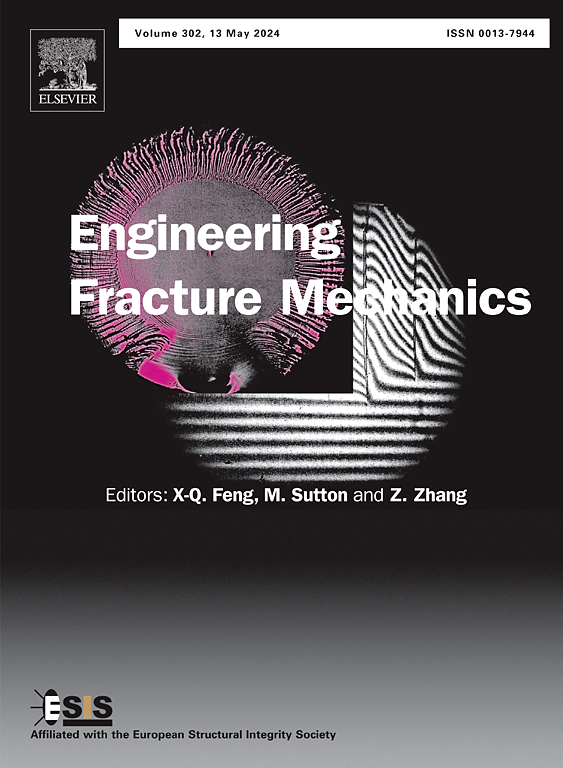Experimental research on hydraulic fracture evolution characteristics of multi-well pad fracturing in a tight conglomerate reservoir
IF 4.7
2区 工程技术
Q1 MECHANICS
引用次数: 0
Abstract
Natural gas is considered a cleaner and more efficient energy pillar than oil and coal, so it has become one of the focuses of global energy exploitation. The tight conglomerate gas reservoir has a broad development prospect. However, the previous fracturing experiments focus on single horizontal well fracturing research, and it is difficult to realize the economies of scale development. Therefore, the true triaxial fracturing experiment of three horizontal wells was carried out with the large-size specimen (400 mm × 400 mm × 400 mm) to study the hydraulic fracture (HF) propagation mechanism and the effects of geostress, fracturing sequence, vertical well spacing and fracture initiation position on the HF evolution characteristics during the multi-well pad fracturing in the conglomerate reservoir. The results show that under the stress shadow, the later fracturing HF tends to avoid the stress shadow zone of the preceding HF, and the breakdown pressure gradually increases. A higher horizontal stress difference helps the HF tend to cross the gravel and increases the proportion of tensile events to 73.2 %, but intermediate HF height propagation is inhibited, and the upward propagation distance has a decline of about 31.8 %. The preferential fracturing of the intermediate fracturing well can enable the intermediate HF to extend fully, and the upward propagation distance has an increment of approximately 140.3 %, which improves the reservoir reconstruction effect between the bilateral HFs. Meanwhile, it can intensify the induced stress interference between the HFs and increase the proportion of shear failure to 43.6 %. A shorter vertical well spacing seriously inhibits the upward propagation of intermediate HF height by around 57.9 % and increases the proportion of shear failure to 38.5 % under the induced stress interference. The preferential fracturing in the intermediate fracturing well can enhance the gas productivity, but it is necessary to control the pumping rate or pumping schedule to reduce the frac hit risk. This study can provide theoretical guidance and suggestions for multi-well pad fracturing in field fracturing.
致密砾岩储层多井垫压裂水力压裂演化特征试验研究
天然气被认为是比石油和煤炭更清洁、更高效的能源支柱,因此已成为全球能源开发的重点之一。致密砾岩气藏具有广阔的开发前景。然而,以往的压裂实验主要集中在单水平井压裂研究上,难以实现规模化开发。因此,采用大尺寸试样(400 mm × 400 mm × 400 mm)进行了三口水平井的真实三轴压裂实验,研究砾岩气藏多井垫压裂过程中水力裂缝(HF)的传播机理以及地应力、压裂顺序、垂直井距和裂缝起始位置对HF演化特征的影响。结果表明,在应力阴影作用下,后压裂高频倾向于避开前压裂高频的应力阴影区,击穿压力逐渐增大。较高的水平应力差有助于高频倾向于穿过砾石,并将拉伸事件的比例提高到 73.2%,但中间高频高度传播受到抑制,向上传播距离下降了约 31.8%。中间压裂井的优先压裂可使中间高频充分扩展,向上传播距离增加了约 140.3%,提高了双边高频之间的储层重构效果。同时,它还能加强高频之间的诱导应力干扰,使剪切破坏的比例增加到 43.6%。较短的垂直井距严重抑制了中间高频高度的向上传播,抑制率约为 57.9%,并使诱导应力干扰下的剪切破坏比例增加到 38.5%。在中间压裂井优先压裂可以提高气产,但必须控制抽速或抽速计划,以降低压裂命中风险。本研究可为油田压裂中的多井垫压裂提供理论指导和建议。
本文章由计算机程序翻译,如有差异,请以英文原文为准。
求助全文
约1分钟内获得全文
求助全文
来源期刊
CiteScore
8.70
自引率
13.00%
发文量
606
审稿时长
74 days
期刊介绍:
EFM covers a broad range of topics in fracture mechanics to be of interest and use to both researchers and practitioners. Contributions are welcome which address the fracture behavior of conventional engineering material systems as well as newly emerging material systems. Contributions on developments in the areas of mechanics and materials science strongly related to fracture mechanics are also welcome. Papers on fatigue are welcome if they treat the fatigue process using the methods of fracture mechanics.

 求助内容:
求助内容: 应助结果提醒方式:
应助结果提醒方式:


